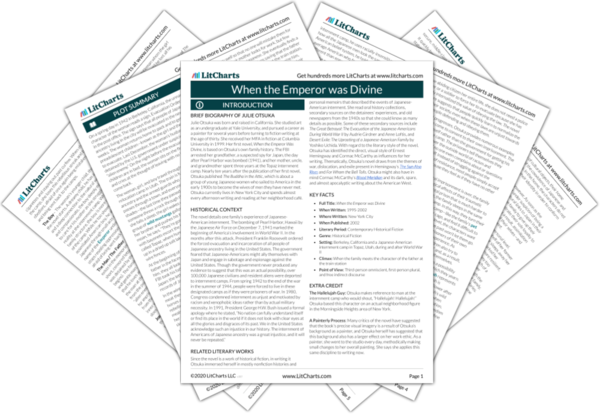Racism
Beginning in February, 1942, the United States government sent over 100,000 Japanese-Americans to internment camps for the duration of World War II. After the bombing of Pearl Harbor, the U.S. government feared that Japanese-American citizens would ally themselves to Japan and engage in acts of sabotage and espionage against America. In the 1980s, however, a congressional commission reviewed the situation and found little evidence of Japanese-Americans having expressed any disloyalty to the United States. The…
read analysis of RacismThe Model Minority
The term “model minority” refers to minority groups that have supposedly achieved high levels of socioeconomic success in America. The term initially was used to describe Japanese-Americans, but has since extended to include people from Jewish, East Asian, and South Asian communities as well.
In this novel, Otsuka suggests that the experience of internment acted as a sort of cultural trauma in the minds of Japanese-Americans, causing them to react by seeking conventional forms of…
read analysis of The Model MinorityImprisonment and Freedom
While reading When the Emperor was Divine, some readers might ask themselves why Japanese-Americans did not resist their own unlawful incarceration. The novel answers this question in the opening scene, when the woman obligingly follows the evacuation order displayed in the post office window. For the woman, being a good citizen entails following the nation’s laws. Having lived as a law-abiding citizen her entire life, she does not need a police officer or a…
read analysis of Imprisonment and Freedom
Assimilation and Loss of Identity
Typically, assimilation refers to a group of people with their own heritage, traditions, and values adopting the culture of another group. But rather than the mingling of two cultural identities, When the Emperor was Divine depicts Japanese-American assimilation as more like the gradual loss of one’s identity altogether.
Before the war, the family’s home was full of the markers of their assimilated, Westernized life (a grand piano, a framed picture of a classic Western artwork…
read analysis of Assimilation and Loss of IdentityInscrutability and the Unknown
At one point in the novel, the boy refers to all the Japanese-American people in the camp as “inscrutable,” which means that they are impossible to know. This “inscrutability” was the exact reason why the U.S. government locked up innocent Japanese-American citizens. Since the government could never know for sure the loyalties of these citizens, the government decided to just incarcerate them all.
Otsuka explores this idea of inscrutability in a number of ways in…
read analysis of Inscrutability and the Unknown












Social Class and the American Dream
The novel opens with the family having achieved the economic prosperity and success associated with the “American dream.” Wealthy enough not to have to work, the woman’s life is full of traditional American signs of prosperity and class. She owns her house in the suburbs, wears white gloves, and hires a maid to clean her house. For all intents and purposes, she has achieved the American dream of a secure, middle-class lifestyle.
It quickly…
read analysis of Social Class and the American Dream